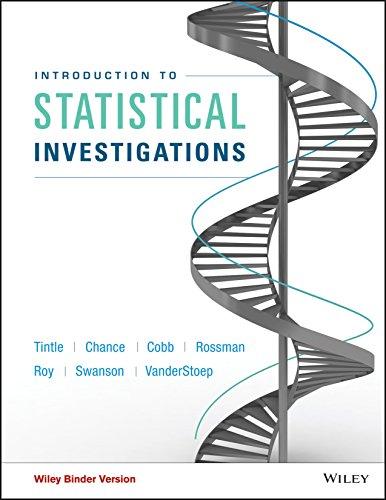Students in a statistics class in a four-year university in California were randomly assigned to be asked
Question:
Students in a statistics class in a four-year university in California were randomly assigned to be asked one of the following three questions:
• Suppose that a part of the state of California was affected by a devastating earthquake, and you were contacted via e-mail by the American Red Cross, requesting you to make a monetary donation. How much ($) would you be willing to donate?
• Suppose that a part of the state of Kansas was affected by a devastating tornado, and you were contacted via e-mail by the American Red Cross, requesting you to make a monetary donation. How much ($) would you be willing to donate?
• Suppose that a part of the state of Maine was affected by devastating floods, and you were contacted via e-mail by the American Red Cross, requesting you to make a monetary donation. How much ($) would you be willing to donate?
Research question: Does being farther away from a disaster site affect our giving spirit?
a. Identify the observational units.
b. Identify the variable(s) measured. Also identify the type (categorical or quantitative) and the role (explanatory or response) for each variable.
c. Define the parameter(s) of interest in the context of the study and assign symbol(s) to the parameter(s).
d. State your hypotheses, in symbols. The data are available in the file Donation.
e. Run an appropriate simulation-based analysis to test the hypotheses stated in part (d). Report the test statistic and p-value.
f. Use technology (either an applet or statistical soft ware) to implement the ANOVA test to test whether self-esteem scores differ significantly for any of the treatments. Be sure to report the F-statistic and the corresponding p-value.
g. Based on the p-value reported in part (f), state an appropriate conclusion in the context of the study. Be sure to comment on statistical significance, causation, and generalization along with how you are making your decision.
h. State the conditions under which the results from the theory-based ANOVA test would be valid. In the context of this study, is it valid to use the ANOVA test? Explain how you are deciding.
i. If appropriate, perform follow-up analysis. If you do not think follow-up analysis is appropriate, explain why not.
j. Even though this study was a randomized experiment, there is at least one possible confounding variable. Identify the confounding variable.
Step by Step Answer:

Introduction To Statistical Investigations
ISBN: 9781118172148
1st Edition
Authors: Beth L.Chance, George W.Cobb, Allan J.Rossman Nathan Tintle, Todd Swanson Soma Roy





